Adrian Collins's Blog, page 127
August 21, 2022
REVIEW: A Dance with Dragons by George R.R Martin
After the uneven A Feast for Crows, George R.R. Martin is back in peak form with A Dance with Dragons, the fifth book in A Song of Ice and Fire. Daenerys Targaryen, Jon Snow, and Tyrion Lannister are all back as main characters after being excluded from the previous volume.
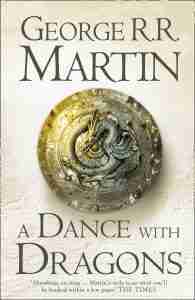 A Dance with Dragons kicks off with a bang as Tyrion Lannister is smuggled across the sea to the neighboring land of Essos, seeking refuge after the harrowing events at the end of the third book, A Storm of Swords. Tyrion discovers much about himself during his time in Essos, especially as he meets the charming Penny, a dwarf woman who initially attacks Tyrion but later befriends him. Tyrion and Penny experience terrible hardships together as they are sold into slavery.
A Dance with Dragons kicks off with a bang as Tyrion Lannister is smuggled across the sea to the neighboring land of Essos, seeking refuge after the harrowing events at the end of the third book, A Storm of Swords. Tyrion discovers much about himself during his time in Essos, especially as he meets the charming Penny, a dwarf woman who initially attacks Tyrion but later befriends him. Tyrion and Penny experience terrible hardships together as they are sold into slavery.
Up at the Wall, Jon Snow struggles in his role as Lord Commander of the Night’s Watch, being torn between honoring his vows of neutrality and allying with Lord Stannis to rescue Winterfell. Jon has been put in this leadership role before he was truly ready. His story arc in A Dance with Dragons is both extraordinary and tragic. I especially enjoyed the interactions among Jon, Stannis, and Melisandre, one of my favorite side characters who receives her first point of view chapter in A Dance with Dragons, a very welcome addition to the book.
In a novel with many high points, I think Daenerys Targaryen’s storyline was my favorite. I love her growth throughout the book as she fights against slavery while also managing the more nuanced elements of politics. The final chapter from her point of view was absolutely perfect, one of the most beautifully written chapters of the entire series.
While Arya Stark has adopted many different pseudonyms over the course of the series, in A Dance with Dragons there is a new twist as a different girl assumes Arya’s identity. This plot thread also features Theon Greyjoy, similarly disguised under a new persona. Meanwhile, the real Arya is doing her best to survive in a foreign cult. Although she is only given two chapters in A Dance with Dragons, they are both excellent.
Regarding the other Stark children, Bran only has three chapters in A Dance with Dragons, but they contain some of his most interesting scenes since A Game of Thrones. Sansa Stark is missing from the book, but fortunately she already had a great story arc in A Feast for Crows. The perpetually overlooked youngest Stark child, Rickon, is also absent from A Dance with Dragons, but that is nothing new. I expect that he will play a more important role in the next book, The Winds of Winter, when it is finally published.
Cersei Lannister was the star of A Feast for Crows, where we witnessed the dramatic descent of her psychological wellbeing in tandem with her loosening grip on power. George R.R. Martin picks up Cersei’s storyline in the second half of A Dance with Dragons, which is just as captivating as in the previous book. Cersei finally faces justice, suffering the ultimate humiliation as punishment for her many transgressions.
A Dance with Dragons is George R.R. Martin at his finest. With action spread evenly across two continents, A Dance with Dragons has the most expansive worldbuilding yet in the series. Martin somehow maintains a brisk pace across more than 1000 pages, giving the reader many hours of enjoyment (in conjunction with a good arm-strengthening exercise). Despite multiple cliffhanger endings, I found the conclusion of A Dance with Dragons to be highly satisfying as we (patiently) wait for the upcoming sixth volume of the series, The Winds of Winter. Winter is coming; we just don’t know when.
5/5
The post REVIEW: A Dance with Dragons by George R.R Martin appeared first on Grimdark Magazine.
August 19, 2022
REVIEW: House of the Dragon – Episode 1
It’s been over three years since the final season of the monumental Game of Thrones aired on TV. Three years for the audience to discuss the great points that soared higher than a fully-grown dragon, and the low points, which most would argue put a dampener on the final season or two. Finally, Game of Thrones is back on TV with a prequel, House of the Dragon, which travels back almost 200 years before the time of Daenerys Targaryen and finds the Targaryens and their dragons at the height of their power in Westeros. To those fans who are slightly nervous about the return to George RR Martin’s world, relax. House of the Dragon E1 reminds you of everything you loved about Game of Thrones and more. Bloody, brutal, sexy, and powerful – this is the perfect way to start the tale of Fire and Blood.
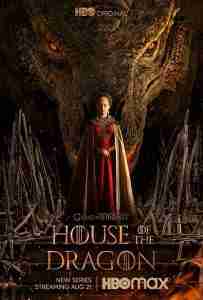 King Viserys I sits on the Iron Throne. He adores his wife, Aemma, and daughter Rhaenyra. But he craves a son to secure the line of succession. Viserys’ brother, Prince Daemon (played by a perfectly cast Matt Smith) considers himself to be heir to the throne but his love of brothels, drinking, and fighting means that he isn’t a popular choice of those on the small council, especially the ambitious Otto Hightower, Hand of the King. Despite all his flaws, Daemon is loved by his brother and his niece, even when he seems to overstep the mark in his role as Commander of the City Watch. In House of the Dragon E1, King Viserys invites warriors from across Westeros, including his rogue of a brother, to compete in a tournament the week his wife is due to give birth to his son, a great celebration for the realm – but in true Game of Thrones style, things do not go to plan…
King Viserys I sits on the Iron Throne. He adores his wife, Aemma, and daughter Rhaenyra. But he craves a son to secure the line of succession. Viserys’ brother, Prince Daemon (played by a perfectly cast Matt Smith) considers himself to be heir to the throne but his love of brothels, drinking, and fighting means that he isn’t a popular choice of those on the small council, especially the ambitious Otto Hightower, Hand of the King. Despite all his flaws, Daemon is loved by his brother and his niece, even when he seems to overstep the mark in his role as Commander of the City Watch. In House of the Dragon E1, King Viserys invites warriors from across Westeros, including his rogue of a brother, to compete in a tournament the week his wife is due to give birth to his son, a great celebration for the realm – but in true Game of Thrones style, things do not go to plan…
The episode brilliantly re-introduces the audience back into the stunning world of Westeros. It introduces new characters and rivalries effortlessly and the use of imagery and music throughout serves to remind viewers of what made them fall in love with Game of Thrones in the first place. House of the Dragon E1 hits the ground running with all the violence, gore, sex, and political intrigue that made Game of Thrones one of the greatest fantasy series of all time. The dialogue is just as crisp and biting with Matt Smith a particular standout in the opening episode – his delivery of one particular word in the throne room is sure to draw laughs from all watching. The meetings of the small council are full of the wit and sharp dialogue that used to come from the mouths of Tyrion and Tywin and it feels as though the showrunners know exactly what fans want to see and hear from the new series and want to give it to them. And then there are the dragons… The CGI is astounding and the adult dragons, Sunfyre and Caraxes being my personal favourites, are just incredible to watch on screen.
House of the Dragon reminds series like The Wheel of Time and The Witcher that there is a long climb left to challenge the king of fantasy series who sits on top of the Iron Throne. Great writing and a wonderful cast fill a brutal, bloody first episode that promises a show with Fire and Blood. The Dance of Dragons has begun, and I can’t wait to watch the rest unfold. Game of Thrones is back – and House of the Dragon could even fly higher than its much-loved predecessor. Must watch TV.
The post REVIEW: House of the Dragon – Episode 1 appeared first on Grimdark Magazine.
August 18, 2022
An Interview with Karen Heuler
Karen Heuler’s latest novel, The Splendid City, is something truly special. It tells the story of a young witch, Eleanor and her cat, Stan, who is in reality an annoying man… whom she dealt with in the most practical fashion. It is a brilliantly unique book – do check our our review – and it was a pleasure to chat to Karen about The Splendid City, Stan and writing more generally.
GdM: Can you please describe The Splendid City in one sentence for our readers?
A novice witch transforms a bullying coworker into a cat and her coven sends them both to a state that has broken away from the USA and thrives on parades, giveaways, and surprises.
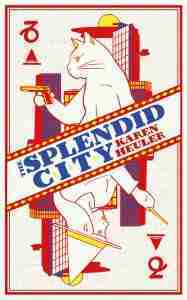 GdM: I absolutely loved reading about Stan, the man turned into a cat. Was he always going to be a cat, and what led you to that choice?
GdM: I absolutely loved reading about Stan, the man turned into a cat. Was he always going to be a cat, and what led you to that choice?
He started out as a cat in my imagination, and then it was easy to see him as a man. Dog humor is mostly joy, and cat humor can be much more deliberate and sarcastic (consider cats knocking things off countertops). He swaggers. He flicks his tail. He shoots people occasionally (but never kills them). He’s that kind of cat.
GdM: Are there any literary witches that particularly inspired you in your writing?
I should probably mention how much this book is a tip of the hat to Mikhail Bulgakov’s The Master and Margarita, a book that had a major impact on me. In it, the devil comes to Moscow, accompanied by a big black cat in order to disrupt the literary politics in the city. My Stan is a descendent of the devil’s cat Behemoth, and in particular the cover of the 1967 Signet paperback edition, which had a big black cat in a bow tie waving a gun. Margarita is a new witch in the book, and I loved her first broomstick ride so much that she has probably become my standard for a witch (not the bad witch in The Wizard of Oz, who is probably the one most people think of). Over the years, the Practical Magic witches (by Alice Hoffman) added to the image I had of witches who are caring rather than frightening.
GdM: Were there any quirky details you found in your research that you weren’t able to put into the finished book?
I would have loved to use the belief that witches stole men’s penises and made them pets. You’d think it would fit in somewhere, but it didn’t.
GdM: What did you enjoy most writing The Splendid City?
Well, Stan, of course. Even though he’s pushy, sarcastic, manipulative and selfish to the core, he’s also funny. I love his comments like “I only shoot once a day,” and “I never kill them, you know.” I also love when, after he and a companion float endlessly down the missing river and discover that it leads to the water bottling site, that the first thing he says is, “Um, I peed in that water. I think you should know.” So much about Stan is our nasty inner monologues being voiced in such a way that he gets away with it. Whenever I’m nasty, it’s never funny, but when he is, I have to smirk. This is entirely irrelevant, but I read somewhere that Kafka used to laugh when he was writing. I did too.
GdM: What comes first for you, character, plot, or setting?
I’m a plot person, primarily, although I had Stan before I really had the story. He’s disruptive, and he represents an amoral urge that we all have to deal with on some level (both personally and politically). When the times themselves became disruptive, he found his setting.
GdM: You’ve been writing – and publishing – for a while. But what stood out most working with Angry Robot in comparison?
I had the greatest sense of a team working together at Angry Robot. I’ve had some wonderful experiences in the past (and a few bad ones), so I was grateful for the many exchanges I had with my editor and marketing team. In fact, they dedicated someone to work on my marketing, and I felt a continued support from them all the way through.
GdM: How are you celebrating your book’s release?
I hate to tell you how addicted I now am to Googling myself. Every new sale is a celebration. I’ve had the president’s head made into paper cutouts, and I made “protest” signs (there’s always a parade or an orchestrated protest in Liberty, to keep things fun). When I do a live reading, the heads and the signs get given out to members of the audience and get raised at the appropriate time. This amuses me.
GdM: What books or other media have filled your creative well recently?
This may not be directly relevant, but the most surprising cultural immersion recently was going to the “American Utopia” production featuring David Byrne I fell in love with him and saw it twice. That’s all. I don’t want to talk about it. I’m thinking of sending him a signed copy of my book and I’m researching love spells. Maybe that’s unethical. But if it works, I’ll live with it.
GdM: What are you working on next?
I’ve just sent a new novel to my agent. I have a story coming out in Asimov’s next year, my first with them and it’s exhilarating. I have a collection coming out from Fairwood Books this fall or winter, and a literary collection later this summer. It sounds like I’m amazing, but the collections and the novel happened over years. I have a lot of story starts I’d like to finish, and then of course, I’m open to a new idea for a book—come this way, new idea. Come here.
The post An Interview with Karen Heuler appeared first on Grimdark Magazine.
An interview with Miles Cameron
Miles – or sometimes, Christian – Cameron is a true Renaissance man. Writer of many genres, from historical to fantasy to science fiction, good with a sword, dashing in armor and knowledgeable on just about every topic under the sun. A conversation with him leaves you full of new ideas, and if you’re lucky enough to attend one of his readings, you will want to go out and buy the book immediately without knowing much about it.
We at Grimdark Magazine were able to pin him down for a chat about his new book, Against All Gods, an epic fantasy set in the Bronze Age, and out now from Gollancz in the UK, writing and research.
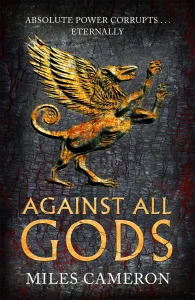 GdM: Can you pitch Against All Gods in one sentence for our readers?
GdM: Can you pitch Against All Gods in one sentence for our readers?
A handful of flawed mortals set themselves against a pantheon of selfish, venal, and very powerful gods.
GdM: Why set your fantasy in the Bronze Age? What inspired you to pick the period, and were there perhaps any archaeological sites or finds that especially drew you to it?
I was inspired by the nearly untouched potential of our real Bronze Age, from the Epic of Gilgamesh and the Iliad to the Mayan legends and of course, Ancient Egypt. There are fantastic civilizations in the distant past, and yet it’s all… wilder. Bigger. More colourful. I was literally awestruck to stand in the Lion Gate at Mycenae a few years ago and look at the incredible stonework, but I feel the same way about Egyptian art, Hittite pantheons, and the whole world of Mesoamerica. I wanted it all…
GdM: What were some of your biggest challenges writing and researching for a story set in the Bronze Age?
Not to belabour the obvious but there’s a real lack of written record, and I like to know how ancient systems worked, even when I’m making things up. On the other hand, there’s a great deal of really good (and bad) archaeology, and this IS fantasy; I could use the existing record as inspiration, but I had a pretty clean slate for creation and worldbuilding.
GdM: Was there a random tidbit of information you found during your research for Against All Gods that really surprised you?
Yes, and I made it into a major martial arts theme; the existence of Minoan/Myenaean bull-leapers and their possible links to a Bronze Age martial art. That was an amazing discovery, or at least that’s my reading of it. But at the same time, I was constantly wowed at museum after museum by the incredible quality of the art, where in Ur or Babylon or Egypt or Greece. My favourite tidbit? A hefty proportion of all the trees on earth were cut down in the bronze age, because bronze axes were really efficient.
GdM: I know you do reenactment as well as writing, is there any weapon in particular from this new series that you have recreated or would like to in the future?
Yes, I’d really like someone to reconstruct a Minoan/Mycenaean long bronze sword. They are as long as Medieval longswords, my favourite weapon. I’d really like to know about their durability and utility. There certainly are a great many of them in the archaeological record.
GdM: Where do you begin to construct a story, with characters, plot or setting?
I’m a big fan of Aristotle’s method. I start with characters; characters have motivations, motivations create plot. Once the characters are well-established in my head, they kind of write themselves. Once I reach that point, I often stop, go back and do a serious ‘world build’ as if I was starting an RPG campaign. In fact, sometimes I run an RPG campaign because other people bouncing around my world building ask all the wrong questions and make me think and create more.
GdM: Theology plays an important role in your story. Where do you find your inspiration to construct your religious system and where do you start crafting it?
I’m a big fan of theology and cosmology. My favourite DM used to say that ultimately all fantasy depends on the quality of the cosmology behind it. This isn’t always true, but it shaped my method. Mind you, and I hope this isn’t a spoiler, AAG exists in the same ‘hermetical multiverse’ as Cold Iron and the Traitor Son books, so I knew, ultimately, what the rules and the ‘upper limit’ of my worldbuilding was.
The religious system itself is loosely based on the combined cosmologies and legends of Egypt, the Hittites, the Bronze Age Greeks, with inputs from Ancient India and what I could glean of Mesoamerica. I enjoyed counter-posing the absolute tyranny of the Gods with a fully-formed society of ethical pacifists; some people believe the Hrapan/Indus Valley culture of the Bronze Age were the for-runners of modern Jains. That was fun. And, I hope, really different for readers. Pacifists in a bloody world of constant strife? How do they survive and even prosper? Answer… carefully and cautiously.
GdM: You have written widely across historical fiction, fantasy and science fiction. Is there any particular era or cultural background you’d still like to set a story in?
I pretty much like everything. If I could find the research materials, I’d love to do something in a setting like Han or Tang China, or Moghul India. I’ve always been fascinated by Tamerlane. And the Byzantine Empire. And… well, everything. Usually, I read a book by someone else and suddenly a whole idea pops into my mind and I’m off…
GdM: What books or other media have been filling your creative well recently?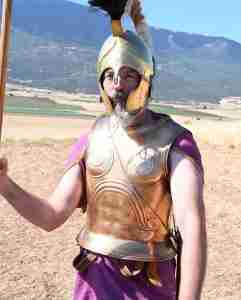
As you may have noticed from my social media feed, I’ve been going deep into Ancient Greece lately because I helped create and run a major reenactment at Plataea in Boeotia, Greece (check out our website at www.plataea2022.com with hundreds of new photos on the way.) So you’re probably not asking about my 11th re-read of Herodotus, or my fascination with a superb book by Stella Spantidaki on Textile Production in Ancient Athens, although I assure you this is my standard reading material.
But, as I always tell people, the way to write good fantasy is to read other people’s good fantasy. So I recently read A Drowned Kingdom by P.L. Stuart, which was superb; a nice break from the Ancient world as his is very firmly set in a late medieval world. And then I tripped over R.J. Barker’s The Bone Ships and I’m still sailing those seas; incredible stuff. Inspiring, beautiful world building. And as Grim and Dark as you could possibly want. And I have Ed McDonald’s Daughter of Redwinter on my bedside table; next up, as soon as I finish a research book. I love Ed’s work and I know it will thrill me, and also provide relief from the research.
But if people are looking for books that thrilled me with their research, I’d recommend The Inquisitor in the Hat Shop by Federigo Barbierato. The Venetian Inquisition… not what you expected… and Agents of Empire by Noel Malcolm has the material for fifty different novels. More incredible stuff. Shall I go on? Hey, you asked.
Read Against All Gods by Miles Cameron
The post An interview with Miles Cameron appeared first on Grimdark Magazine.
August 17, 2022
REVIEW: The Splendid City by Karen Heuler
Just after finishing Karen Heuler’s The Splendid City, I emailed the publicist saying that this is a very special book and we need more like this. So you could say I enjoyed this. Set in a futuristic Texas, we follow a young witch and her cat Stan – well, the annoying man in her life who she’s turned into a cat. As a cat, Stan’s no less frustrating, but he’s at least more contained. He spends his days flittering around town, hunting for the best fish tacos and rumours of treasure. And indeed, he hears of a long-lost inheritance rumoured to have been buried in the desert.
 While Stan chases after shinies, as cats are wont to do, Eleanor, his mistress, is dealing with witch politics. Having been banished from her old coven (because of Stan), she is trying to redeem herself – and witches are going missing. It is a whimsical and weird book, but it is so in all the best ways. I devoured this in a single sitting and left it wanting more – feminist witches, talking, sassy, opinionated cats? That is pretty damn up my street. You have a solid plot here, but The Splendid City doesn’t live off plot. It lives of characters, and let’s be honest, it lives off Stan. Eleanor and the witches are pretty amazing, but not much beats the misogynist turned into a cat. And really, Stan is so much happier as a cat than he was as a man. Except for the thumbs. He’d like those back, please.
While Stan chases after shinies, as cats are wont to do, Eleanor, his mistress, is dealing with witch politics. Having been banished from her old coven (because of Stan), she is trying to redeem herself – and witches are going missing. It is a whimsical and weird book, but it is so in all the best ways. I devoured this in a single sitting and left it wanting more – feminist witches, talking, sassy, opinionated cats? That is pretty damn up my street. You have a solid plot here, but The Splendid City doesn’t live off plot. It lives of characters, and let’s be honest, it lives off Stan. Eleanor and the witches are pretty amazing, but not much beats the misogynist turned into a cat. And really, Stan is so much happier as a cat than he was as a man. Except for the thumbs. He’d like those back, please.
The Splendid City is a compelling book, compulsively readable. It is a story to get lost in and to then re-orient yourself within the expansive world Heuler creates. And the writing itself stands out too. It is understated but hilarious, funny without being too on-the-nose. It is not a book you will encounter every week, or even every year. It truly stands out – at least to me. In that, it is a true Angry Robot book, one of those books that work so well and fit amazingly with their list, but you may not see in more commercially driven, larger houses. The Splendid City is probably one of the least dark novels we’ve covered here, but there is no less appeal for you to pick it up. After all, cats are probably the most grimdark animals out there. Bloody bastards, living after their chaotic evil moral compass. And witches… Well, Eleanor does say she is looking to be powerful. She’s not quite sure what she wants to do with that power when she gets it, but she is sure she wants it.
Read The Splendid City by Karen HeulerThe post REVIEW: The Splendid City by Karen Heuler appeared first on Grimdark Magazine.
August 16, 2022
REVIEW: Spells for Forgetting by Adrienne Young
Spells for Forgetting by Adrienne Young is the perfect book for what I needed this week. A compelling mystery with a strong romantic element, witchy influences and a good dose of betrayal and moral murkiness. That said, this isn’t quite our usual fare here at Grimdark Magazine, and I expect that not all of you will immediately want to pick this one up. But there is much to enjoy here for lovers of dark and twisted stories, and even we long for some good comfort reading and a book that, despite its deep sense of twisted morals, carries that ember of hope.
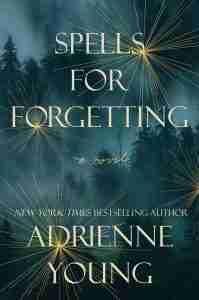 Set on the isolated Saoirse Island in the Pacific Northwest, Spells for Forgetting is filled to the brim with autumnal atmosphere, evoking a misty and grey landscape in which we meet our characters: August has returned to Saoirse to bury his mother’s ashes after a sudden departure years earlier, Emery has never gotten over being left behind, and Lily, well, Lily was murdered just before August left. And everyone thinks he was responsible. And then there’s the matter of August’s grandfather’s orchard, left to the town on his death. As secrets get uncovered and old relationships rekindled, the characters are confronted with their unresolved pasts and no one is safe.
Set on the isolated Saoirse Island in the Pacific Northwest, Spells for Forgetting is filled to the brim with autumnal atmosphere, evoking a misty and grey landscape in which we meet our characters: August has returned to Saoirse to bury his mother’s ashes after a sudden departure years earlier, Emery has never gotten over being left behind, and Lily, well, Lily was murdered just before August left. And everyone thinks he was responsible. And then there’s the matter of August’s grandfather’s orchard, left to the town on his death. As secrets get uncovered and old relationships rekindled, the characters are confronted with their unresolved pasts and no one is safe.
To be entirely honest, I did not expect to fall for Spells for Forgetting as much as I did. I have been following Adrienne Young’s YA writing for most of her career, and really enjoyed her books, especially in regards to writing multiple points of view. As this is her adult debut, and her first book that isn’t set in a secondary world, I wasn’t quite sure what to expect – and found a story that is both dark and comforting, a disconcerting and cosy read. Spells for Forgetting is character-driven rather than hugely fast-paced, focusing on evoking the atmosphere and relationships to present events in their most powerful form. And the island, the landscape, becomes a character of its own right.
While this isn’t a fantasy novel, it does have a magic element. There are spells, witchcraft, an innate magic to Saoirse Island, which helps cement the misty atmosphere against which the story is set. All in all, Spells for Forgetting is a fantastic murder mystery for readers of grimdark who are looking to take a little breather from the very dark, but do not want to compromise on murky morals. A five star read for me.
Read Spells for Forgetting by Adrienne YoungThe post REVIEW: Spells for Forgetting by Adrienne Young appeared first on Grimdark Magazine.
August 15, 2022
REVIEW: The Republic of Thieves by Scott Lynch
Scott Lynch’s third installment in The Gentleman Bastard Sequence, The Republic of Thieves, finds Locke and Jean at the center of a longstanding political game. The forces at play provide our boys the necessity to pool their resources to win at all costs. The only problem: a significant face from the past returns, bringing with them intimate knowledge of Locke and Jean including their innermost operations.
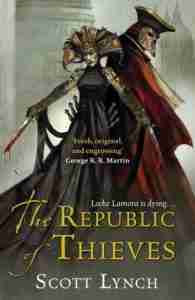 At the start of The Republic of Thieves, Locke and Jean are in the lowest of lows after the events in Red Seas Under Red Skies. Down on their luck and with looming, fatal consequences on their doorstep, they are approached by a mysterious Bondsmagi with an offer that can set everything back on course. Locke and Jean must use their talents to help influence the outcome of a political election the magi have a vested interest in. However, the opposing faction’s hired help to pit against them is someone both boys, especially Locke, know quite well: Sabetha Belacoros, Locke’s greatest and only love. The clash of wills, personal and professional, will force Locke and Jean to reconcile the past while remaking their future.
At the start of The Republic of Thieves, Locke and Jean are in the lowest of lows after the events in Red Seas Under Red Skies. Down on their luck and with looming, fatal consequences on their doorstep, they are approached by a mysterious Bondsmagi with an offer that can set everything back on course. Locke and Jean must use their talents to help influence the outcome of a political election the magi have a vested interest in. However, the opposing faction’s hired help to pit against them is someone both boys, especially Locke, know quite well: Sabetha Belacoros, Locke’s greatest and only love. The clash of wills, personal and professional, will force Locke and Jean to reconcile the past while remaking their future.
Similar to the previous books, The Republic of Thieves has two timelines, one in the present and one in the past, that Lynch interweaves together. The present timeline propels Locke and Jean’s story forward, starting six weeks from where Red Seas Under Red Skies ends. The past timeline provides readers with more insight and depth into the well-established elements from the first book. The connections to what came before are more directly visible and fill in some of the mystery leftover from The Lies of Locke Lamora. Lynch uses his beautiful prose to shape the significant themes of love, sacrifice, pride, and purpose throughout the narrative, specifically in terms of his characters and their arcs: “Nobody admires anyone else without qualification. If they do they’re after an image, not a person” (258).
Where The Lies of Locke Lamora grounds the reader in the story and Red Seas Under Red Skies builds upon those introductions with a nautical twist, Lynch explores a political stage as he continues to flesh out well-known story elements in The Republic of Thieves. Lynch’s quality with regard to his characters, plotting, tone, and settings is consistent across all three books. What changes will be the reader’s interest and investment throughout the tales being told. Some readers might take issue with this latest installment because the book does carry a heavier romantic subplot in comparison to the previous books. Though Lynch executes this brilliantly and realistically, it comes with some cost: the spotlight on character relationships shifts partially away from Locke and Jean to Locke and Sabetha.
As with its predecessors, The Republic of Thieves cements Lynch’s unique place under the grimdark label. Lynch’s ability to balance the dark and grim aspects of humanity with humor and charm is on full display. The book explores how messy life is and how the most important aspect in making a choice isn’t the choice itself. Rather, it’s the fallout the decision brings: “Life is far more easily destroyed than mended. Magic doesn’t change that” (158).
Read The Republic of Thieves by Scott LynchThe post REVIEW: The Republic of Thieves by Scott Lynch appeared first on Grimdark Magazine.
August 14, 2022
Writing Good Tie-In Fiction: Put every writing advice survivorship bias caveat you’ve ever heard here
I love writing tie-ins. My licensed Star Trek and Alien books are some of my favorite works. However, writing advice requires me to be blunt. Please remove your fan hats and t-shirts for a moment if you choose to see how the sausage is made. I don’t want to get stains on your merch.
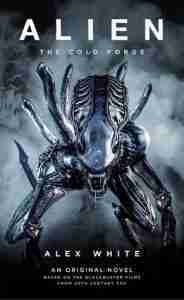 Let’s start with the ugly truth: my goal as a tie-in writer is career recognition. Say what you will, I’m literally doing this for exposure. Tie-in contracts simply aren’t as lucrative: they pay half as much and I get half the time to write them, so I must be strategic about what I write and for whom.
Let’s start with the ugly truth: my goal as a tie-in writer is career recognition. Say what you will, I’m literally doing this for exposure. Tie-in contracts simply aren’t as lucrative: they pay half as much and I get half the time to write them, so I must be strategic about what I write and for whom.
How can I stand out when tie-in novels are considered the mass-produced, lesser sibling of noble original fiction? Licensed books exist to commodify and extend the story for further monetization, and there’s little recognition in it. The major spec fic awards don’t even have a category for licensed fiction, and they have some pretty esoteric ones. How can I distinguish myself as a raindrop in an ocean?
Don’t try to write the perfect brand experience.At the heart of every book is a goal. On the surface, the goal of a licensed Trek book might be, “Make the missing episode of my favorite series.” That sounds reasonable. It’s easy to build those sets in my mind, and I can work in the fan favorites: transporters, phasers, Earl Grey tea and hot.
But then, everyone already saw all that stuff. It’s table stakes.
For Alien’s horror, which relies on violating expectations, this disadvantage is even more pronounced. No one will be surprised when a guy peering into an egg gets facehugged. Oh, the British android turned evil? Who could’ve guessed that was coming?
If I try my hardest to make that lost episode of a favorite series, and I succeed, it’ll be tossed into a bin with all the other extruded products. Relying on the brand identity to be my plot identity is a great way to be swept under and forgotten. Did you know there are more than 850 Star Trek novels?
My goal is instead to replicate the moment you truly fell in love with that licensed property. How did you feel the first time you saw a chestburster? Shock? Disgust? Fascination? How old were you when you first saw the Enterprise? What possibilities did you imagine?
A great tie-in novel will be both familiar and new. It’ll capture the wonder and depth of your love from a perspective you’ve never seen, turning all your predictions on their heads until you stop guessing and enjoy the ride.
Take risks.It feels like a privilege to have the keys to a major licensed property. It’s a storied place full of sacred wonder for many lifelong fans. The studio that owns it has put a lot of money into it, and they’d like it if I returned it like I found it. However, and I really can’t stress this enough:
One is not privileged to work for a major corporation.
Let me say it again. It’s cool to work with my favorite characters. It’s cool to entertain the fandoms. It’s nothing special to be in the employment of the megacorps.
I’m generating content for their machine, one which can be guided by averages and pocketbooks instead of vision and love. There’s pressure from fans and brands alike to be “apolitical,” which is a word that has worn out its welcome in the politicization of everything. I guarantee, if I write a story about good versus evil, there will be some fascist frothing at the mouth, claiming I’m writing about them.
And sometimes I am. Not sorry.
I can’t be cowardly because it’s some multimillion-dollar property quivering beneath my pen. The world can be a dark and painful place, and some people deserve comfort. Others deserve to have a mirror shoved in their faces. I’ve been lucky to have the support of fantastic editors to protect my works against meddling.
Let the hatred flow through you.Sometimes our favorites disappoint us. If you’re a fan of any large endeavor, it contains elements that you thought were less than perfect. Maybe they were boring, foolish, or problematic. I’ll tell you what the fanfiction world figured out a long time ago:
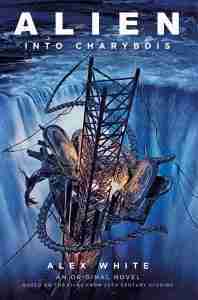 If you hate a story, you can write something to fix it.
If you hate a story, you can write something to fix it.
Readers are always asking me what I loved about the show or movie that inspired my books, and the answers are frankly embarrassing. I wrote The Cold Forge because I thought Carter J. Burke was an ineffective heel, and the situation would be terrifying if he was even a little good at his job. I wrote Revenant because I thought that Jadzia Dax got shortchanged in her interactions with Curzon.
These are complaints. My stories come from gripes half the time.
And honestly, this doesn’t just apply to tie-ins. Sometimes I’ll see a television show do something I despise, and I’ll think, “What an interesting plot. I’m going to scrub off the serial numbers and write a book about that.”
Be an auteur.This is probably trite, but always be yourself. I aim to leave an indelible stain on my tie-in novels, like graffiti on the studio wall. No matter what property covers it, no matter what brands we filter it through, my writing should always be mine. If I try to work in the style of another person, it’s clunky and obtuse. The natural feeling of the prose goes away.
That’s why I don’t take assignments with too much plot work done beforehand. If an editor calls me with, “We have a specific story we need you to write,” the answer is usually, “Thanks for considering me, but no.” It’s hard to write someone else’s plot—far easier to create my own.
The only way for me to achieve my goal is if you remember my name when you’re done. I’m here to create support for my own endeavors. Who wants to work in the worlds of others when they have their own?
One piece of parting advice: never compromise quality. Write your heart out, every single time.
Originally published in Grimdark Magazine Issue #31.
The post Writing Good Tie-In Fiction: Put every writing advice survivorship bias caveat you’ve ever heard here appeared first on Grimdark Magazine.
August 13, 2022
Associating with Antiheroes
I have written before about the fact that many readers delight in a well-written antihero. But… why? Why do we enjoy reading stories which feature characters who teeter on the ledge between hero and villain?
Okay, let me back up a second. For the purposes of this discussion, I am: 1) speaking exclusively of fiction and 2) making the enormous assertion that we read because we find the act of reading enjoyable.
That being said, why do we enjoy reading about antiheroes?
Affective Disposition Theory (ADT) explains why an audience finds a particular narrative enjoyable; the theory predicts that a reader’s pleasure will increase when a likable character experiences positive outcomes as a result of their actions, and also when a disliked character experiences negative outcomes.
The reverse is also true: a reader’s enjoyment of the narrative will be diminished when a liked character experiences negative outcomes, or a disliked character is rewarded.
Further, the reader’s like or dislike of a character is closely tied to both empathy and morality; arguably ‘good’ characters who do ‘good’ things are likable, while ‘bad’ characters who do ‘bad’ things are repellent.
So, for our purposes, there are three components to a reader’s enjoyment of a story: favorable or unfavorable disposition towards a particular character, emotional reactions to that character’s victories and failures, and the cognitive response of the reader to the final outcome of a character’s journey.
It can therefore be assumed that a reader may find enjoyment in reading about a character who is cast from a hero’s mold: a good person who strives to do good things and is ultimately rewarded by the universe for being heroic. A reader can admire such a character, empathize and sympathize with them, cringe when things go badly, cheer when they go well, and ultimately feel delight when the hero wins the day (in what would classically be considered a comedy) or, if the story is meant to be a tragedy, we might experience a cathartic sorrow when the hero fails despite their best efforts. Either way, the cognitive effect of the story upon the reader is one of satisfaction.
Why, then, do we find ourselves cheering for the antihero? If we find a character likable or despicable based on our moral judgment of their character, how then do we explain the satisfaction we feel when Michael Corleone becomes the next Godfather, or when William Munny slaughters an entire saloon full of people and rides off into the sunset, leaving his best friend’s body unburied? Either character neatly fits the description of an antihero: a character who lacks conventional heroic attributes such as idealism, morality, and courage.
Does such enjoyment speak to the hidden nature of the reader, and suggest that a person who gains pleasure from reading about the triumph of a morally ambiguous character is somehow twisted in nature, and therefore, finds themselves attracted to wickedness?
Not necessarily.
A character who is morally ambiguous for the sake of being contrary, or for the joy of being evil, is not an antihero at all, but a villain. A well-written antihero struggles—struggles hard—with their own concept of morality and the drive to do ‘good’ vs. the necessity of doing ‘bad’. The character defines themselves and is defined by both their actions and their moral compass, however broken. And the agony of a character who longs to be a hero but falls short—at least in their own eyes—is exquisite.
Again—why? Why not simply write off such a character as a ‘bad’ person, boo when they succeed, cheer when they fall? What emotional payoff do we get from the antihero’s rise that keeps us coming back for more?
One answer may lie in the concept of affective judgment, which is defined as judgment about the pleasure/displeasure and feeling states we expect to experience when enacting an activity. Similar to the effects of affirmation and positive thinking influencing real life experiences, we enter an antihero’s story rooting for them and expecting to experience the cathartic effects of success when they achieve victory by overcoming their own less admirable qualities, completing a character arc towards the good, and winning the day.
Only… that’s not how the antihero’s journey works. They try to do good things and be good people, but in the end their obstacles can only be overcome by unleashing their darker impulses. Every time they attempt to follow a moral path, their more vicious and villainous adversaries grow stronger, until the only remaining choice is to go dark or go home. And so our antihero goes dark.
We’ve been invested in their story since the first page, cheering them on, knowing that they are going to show themselves to be true and just, and… oops. But they win in the end, and we’ve been anticipating our thrill in their victory all along. We experience pleasure because we had expected ourselves to be pleased. We so want to feel this thrill of victory, in fact, that we morally disassociate ourselves from the bad things our character has to do to win it for us. We excuse murder, mayhem, and all manner of moral violations because we have been anticipating the delight we will feel when our character wins and damned if we’re not going to feel it.
Damned indeed.
Perhaps we ourselves are not as heroic as we’d like to believe.
Originally published in Grimdark Magazine #31
The post Associating with Antiheroes appeared first on Grimdark Magazine.
August 12, 2022
REVIEW: The Boys Season 3
Chances are, if you’re tuning into The Boys S3 – you’ve seen the first two seasons and you’re ready for more outrageous adventures with Billy Butcher, Hughie, and the rest of The Boys as they continue their efforts to take down the despicable Homelander and other ‘Supes’ who have powers but seemingly no honour or empathy. You might be thinking that you’ve seen the madness of the first two seasons and that The Boys S3 wouldn’t be able to push any of the boundaries of TV further. Well, you’d have been wrong; so very, very wrong. In the season opener, Payback, we see superhero Termite (think The Boys’ version of Ant-Man) shrink down before… well, I don’t want to ruin it. Let’s just say that it is clear from the first episode that The Boys S3 sets out to push the limits of what can be shown on TV and fans of the previous seasons and the comics they are based on will not be disappointed.
One year on from the defeat of Stormfront, Hughie and The Boys are working for the Bureau of Superhuman Affairs. If Stormfront was the catalyst to propel the story forward in Season 2, then for The Boys S3, it is Soldier Boy’s turn. Billy aims the one supe capable of taking on Homelander at the despicable and increasingly unhinged villain and the fallout of his actions impacts everyone. The Boys S3 is just as violent and shocking as we’ve come to expect, but this season adds layers of vulnerability to almost all of the characters we follow. The show breaks down the main cast and puts them through the wringer to see what they might become on the other side. Hughie has to question what it means to be strong as he fights the urge to protect Starlight or allow her to protect him. Mother’s Milk battles with ghosts from his past and the tough task of raising his daughter whilst her stepdad offers her a completely different world view to the one he wants. Even Billy is given a chance to showcase his vulnerable side as he relives horrors from his past and fights against the idea that he is turning into the father he so despised. He is able to show glimpses of kindness and empathy in his own grim way as he pushes away those closest to him in the hope that it keeps them from danger.
The writing of The Boys S3 is some of the best on TV at the moment. The moments in the series that make you feel uncomfortable aren’t the violent, sickening acts of the characters before you, but the way in which the show effortlessly manages to shine a light on Western society and current politics. Homelander’s speeches throughout this season are frighteningly similar to certain politicians who have gained power in recent memory and the way in which vile and despicable actions are so easily glossed over and even supported by masses is scarily realistic for the audience. The Boys S3 does what great shows should do: entertain whilst provoking thought and debate. It helps to have an actor like Anthony Starr playing Homelander in what should be an award-winning role. Starr plays the villainous role to perfection and is somehow able to be the most hated character on the show whilst still managing to draw out moments of sympathy and pity as a man alone who craves the affection and admiration of those around him but doesn’t know how to get it without using fear and violence as his tools. The one misgiving I have of this season is the final episode. It felt as though the gun had been loaded throughout the season ready for a final explosive payoff but it ended with a whimper and the status quo of the show pretty much back in place.
Bloody, violent, and thought-provoking – this is the best series of The Boys so far. A consistently brilliant show with hilariously grim moments of shocking violence that houses a heart that isn’t quite gold, but is shining through nonetheless. Other than a small misstep at the end, this is a brilliant, dark superhero series that will not disappoint. The Boys are back in town and with any luck, they’re here to stay.
Watch The Boys S3Click here to head on over to Amazon Prime (here if you’re in the UK..
The post REVIEW: The Boys Season 3 appeared first on Grimdark Magazine.



